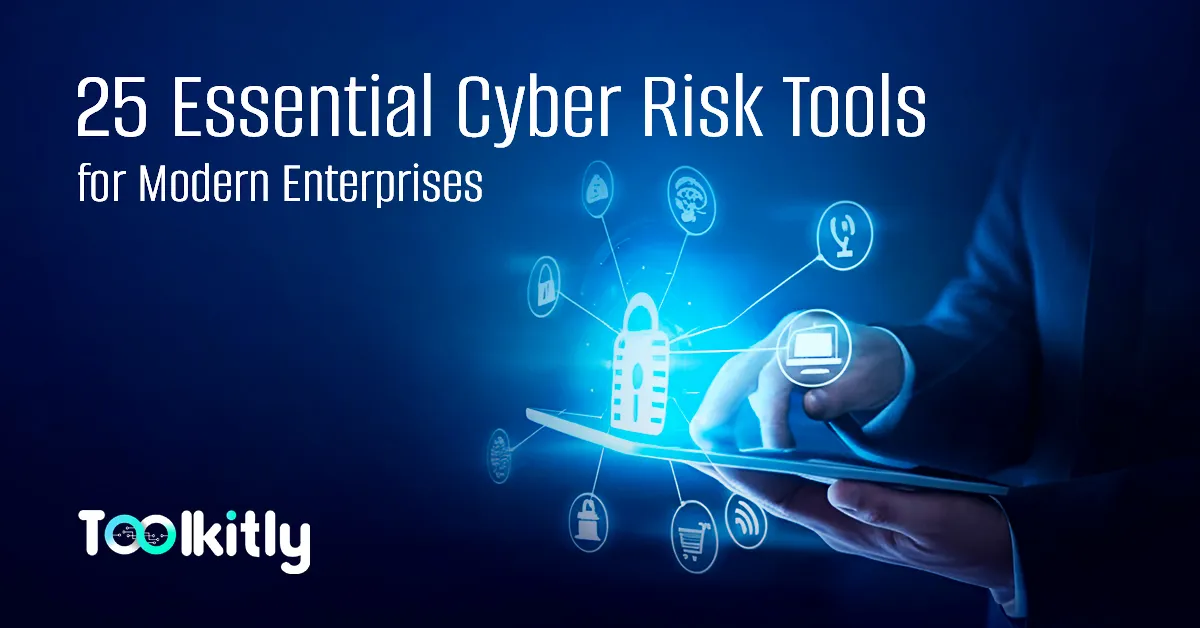
The Evolution of Business Threats: 25 Essential Cyber Risk Tools
Modern enterprises face an unprecedented array of digital vulnerabilities. As organizations embrace cloud technologies and remote work models, their attack surfaces expand exponentially. Security incidents that once affected single companies now ripple through interconnected business ecosystems, creating complex liability scenarios that demand sophisticated evaluation methods.
Beyond Traditional Security Audits
Standard compliance checklists and annual assessments no longer provide adequate protection insights. Organizations require continuous monitoring solutions that deliver real-time threat intelligence and quantifiable risk metrics. These advanced systems help decision-makers understand their actual exposure levels and make strategic investments in defensive measures.
TLDR: The Evolution of Business Threats – 25 Essential Cyber Risk Tools
Modern enterprises face rapidly escalating and complex digital threats, far beyond what traditional security audits can handle.
Need: Organizations require continuous monitoring, real-time threat intelligence, and quantifiable risk metrics to understand and manage their exposure.
Solution: This content outlines 25 essential cyber risk tools designed to assess, quantify, and strengthen digital defenses.
Key Categories of Tools Covered:
- Cybersecurity Ratings & External Assessment: Platforms like BitSight, SecurityScorecard, UpGuard, RiskRecon, and Black Kite provide external security posture evaluations and vendor risk management.
- Cyber Risk Quantification (CRQ): Tools such as Cyence, Kovrr, Axio, CyberCube, QOMPLX, Corax, and Resilience help translate technical cyber risks into financial terms.
- Integrated Insurance & Risk Monitoring: Solutions like Paladin Cyber, At-Bay, and Zeguro combine cyber insurance offerings with active risk assessment.
- Validation & Internal Controls: Platforms like SafeBreach (breach and attack simulation), Panaseer (continuous controls monitoring), and XM Cyber (exposure management) help validate and improve internal defenses.
Overall Value: These tools empower businesses to make informed, strategic investments in cybersecurity, enhance resilience, and proactively manage their evolving threat landscape.
Essential Tools for Modern Risk Management
The platforms outlined below represent innovative approaches to digital threat evaluation. Each solution addresses different aspects of organizational vulnerability assessment, from external attack surface analysis to internal control effectiveness measurement.
1. BitSight: Cybersecurity Ratings Platform
BitSight is a widely-used cybersecurity ratings platform that assesses the security performance of organizations based on externally observable data. It provides a numerical rating that reflects an organization’s security posture, making it a valuable tool for insurers assessing cyber risk.
Key Features:
- Continuous monitoring of security performance.
- Data-driven insights based on internet traffic, malware infections, and more.
- Benchmarking against industry peers.
Why It’s Valuable: BitSight’s ratings help underwriters quickly gauge the cybersecurity maturity of prospective insureds, allowing for more accurate pricing and risk selection.
Explore More: Visit BitSight
2. SecurityScorecard: Security Ratings and Risk Management
SecurityScorecard provides dynamic security ratings and in-depth risk analysis, drawing from a comprehensive set of data points. It assesses critical areas like network security, DNS health, patching frequency, and various other indicators to provide valuable intelligence for cyber insurance providers.
Key Features:
- A proprietary 10-factor risk assessment framework.
- Ongoing monitoring with proactive alerts.
- Management of third-party and supply chain cyber risk.
Why It's Valuable: SecurityScorecard empowers insurers to make data-driven underwriting choices and assists organizations in progressively strengthening their cybersecurity defenses.
Explore More: Visit SecurityScorecard
3. UpGuard: Cyber Risk Rating and Vendor Assessment
UpGuard focuses on third-party risk and cyber risk ratings through its robust platform. It evaluates companies based on risk categories such as data leaks, email security, and web application security.
Key Features:
- Vendor risk assessments and monitoring.
- Data leak detection and breach alerts.
- External risk scoring and benchmarking.
Why It’s Valuable: UpGuard provides deep insights into the cyber hygiene of insureds and their third-party partners, enhancing underwriting accuracy.
Explore More: Visit UpGuard
4. RiskRecon (by Mastercard): Cybersecurity Risk Ratings
RiskRecon offers a platform that continuously monitors and rates the cybersecurity performance of organizations. It evaluates companies across various domains, such as application security and data handling.
Key Features:
- Automated asset discovery and risk assessment.
- Security performance ratings and benchmarking.
- Risk prioritization and remediation guidance.
Why It’s Valuable: RiskRecon empowers insurers with objective data to assess and price cyber risks more precisely.
Explore More: Visit RiskRecon
5. Cyence (by Guidewire): Economic Cyber Risk Modeling
Cyence, now a part of Guidewire, specializes in modeling the economic impact of cyber risk. It combines cybersecurity data with economic modeling to help insurers quantify potential losses.
Key Features:
- Cyber risk quantification in financial terms.
- Scenario-based loss modeling.
- Integration with underwriting and portfolio management tools.
Why It’s Valuable: Cyence bridges the gap between technical cyber data and actuarial modeling, enabling better risk selection and portfolio management.
Explore More: Visit Guidewire Cyence
6. Kovrr: Data-Driven Cyber Risk Quantification
Kovrr provides a cyber risk modeling platform that uses data-driven methodologies to assess and quantify risk across multiple scenarios. It supports underwriting, risk aggregation, and reinsurance decisions.
Key Features:
- Real-time cyber risk modeling.
- Global threat intelligence and historical incident data.
- Catastrophe modeling and loss forecasting.
Why It’s Valuable: Kovrr enhances insurers’ ability to assess cyber risk on a granular and portfolio-wide level, supporting profitable growth.
Explore More: Visit Kovrr
7. Axio: Cyber Risk Quantification & Decision Support
Axio is a cyber risk quantification platform that helps organizations measure their cyber risk in financial terms. It supports decision-making for risk management, insurance purchasing, and cyber resilience strategies.
Key Features:
- Risk scenarios mapped to financial impact.
- Support for NIST CSF and other frameworks.
- Board-ready reporting and analytics.
Why It’s Valuable: Axio enables underwriters and risk managers to align cybersecurity investments with business risk exposure.
Explore More: Visit Axio
8. Paladin Cyber: Automated Risk Assessment and Insurance
Paladin offers automated risk assessments for small and medium-sized businesses and links them directly with cyber insurance offerings. Its tools provide pre-binding risk assessments and ongoing monitoring.
Key Features:
- Fast, automated cyber risk assessments.
- Integration with insurance distribution channels.
- Cybersecurity tools and recommendations.
Why It’s Valuable: Paladin helps insurers streamline the underwriting process for SMBs while promoting better risk hygiene.
Explore More: Visit Paladin Cyber
9. At-Bay: Cyber Insurance with Active Risk Monitoring
At-Bay combines cyber insurance with active risk monitoring services. Its underwriting model uses technical scans and assessments to tailor policies and mitigate risks.
Key Features:
- Continuous external risk monitoring.
- Technical scans during underwriting.
- Active risk management recommendations.
Why It’s Valuable: At-Bay’s proactive approach helps reduce claim frequency and enhances insureds’ security posture.
Explore More: Visit At-Bay
10. Zeguro: Integrated Cybersecurity and Insurance Platform
Zeguro offers an integrated platform combining cybersecurity tools with cyber insurance. It helps businesses identify vulnerabilities and offers training and monitoring.
Key Features:
- Risk assessments and employee training.
- Website and web app scanning.>
- Tailored insurance coverage.
Why It’s Valuable: Zeguro empowers SMBs with accessible tools and insurance products to manage cyber risk efficiently.
Explore More: Visit Zeguro
11. Black Kite: Cyber Risk Intelligence & Rating
Black Kite delivers cyber risk intelligence and technical risk ratings based on open-source intelligence (OSINT). It includes financial impact modeling and threat assessment.
Key Features:
- 300+ controls mapped to standards (NIST, ISO, etc.).
- FAIR-based risk quantification.
- Ransomware susceptibility scores.
Why It’s Valuable: Black Kite provides insurers with a deep, standards-aligned view of cyber risk with financial translation.
Explore More: Visit Black Kite
12. CyberCube: Cyber Risk Analytics for Insurers
CyberCube delivers data-driven cyber risk analytics for the insurance industry. It supports portfolio modeling, risk selection, and pricing optimization.
Key Features:
- Catastrophe modeling and scenario simulation.
- Exposure and accumulation management.
- Threat intelligence and incident trend analysis.
Why It’s Valuable: CyberCube is a go-to solution for insurers needing actuarial-grade cyber analytics at scale.
Explore More: Visit CyberCube
13. Arceo.ai (now Resilience): AI-Powered Risk Assessment
Arceo.ai, now operating as Resilience, uses AI to evaluate cyber risk and provide underwriting support. It integrates technical and business intelligence into risk modeling.
Key Features:
- AI-based scoring and risk modeling.
- Risk mitigation insights and tools.
- Data feeds from internal and external environments.
Why It’s Valuable: Resilience empowers cyber insurers with smart analytics to dynamically manage cyber risk across portfolios.
Explore More: Visit Resilience
14. QOMPLX: Risk Cloud for Cyber and Operational Risk
QOMPLX offers a Risk Cloud platform that enables advanced modeling of cyber risk and operational resilience. It integrates diverse data sources for comprehensive insights.
Key Features:
- Data fusion and analytics engine.
- Cyber insurance modeling and risk scoring.
- Threat intelligence and real-time analytics.
Why It’s Valuable: QOMPLX provides insurers with a robust platform for understanding complex risk interdependencies.
Explore More: Visit QOMPLX
15. Resilience: Cyber Risk Management & Insurance
Resilience, originally known as Arceo, provides cyber risk quantification, insurance solutions, and continuous risk monitoring. It helps clients align cybersecurity strategy with financial risk.
Key Features:
- Continuous risk evaluation and mitigation support.
- Cyber insurance integration.
- Executive-level risk reporting.
Why It’s Valuable: Resilience helps align insurance coverage with real-time risk exposure, supporting smarter underwriting.
Explore More: Visit Resilience
16. SafeBreach: Breach and Attack Simulation
SafeBreach offers a breach and attack simulation platform that continuously tests an organization’s defenses. The results can be used to quantify risk and validate controls.
Key Features:
- Continuous breach simulation and gap detection.
- MITRE ATT&CK mapping.
- Executive dashboards and reports.
Why It’s Valuable: SafeBreach supports dynamic risk scoring by validating the effectiveness of security controls in real-time.
Explore More: Visit SafeBreach
17. Panaseer: Continuous Controls Monitoring
Panaseer helps organizations continuously assess the effectiveness of cybersecurity controls. It aggregates data from multiple sources to evaluate risk exposure.
Key Features:
- Continuous Controls Monitoring (CCM).
- Data-driven metrics for risk and compliance.
- Custom risk models.
Why It’s Valuable: Panaseer allows insurers and organizations to validate that controls are working effectively, reducing guesswork in risk scoring.
Explore More: Visit Panaseer
18. XM Cyber: Exposure Management Platform
XM Cyber provides an exposure management platform that simulates attack paths and vulnerabilities within networks. It helps quantify the potential business impact of cyber threats.
Key Features:
- Continuous risk exposure simulations.
- Prioritized remediation plans.
- Business impact quantification.
Why It’s Valuable: XM Cyber enables security and risk teams to focus on what matters most — exposures that lead to real business risk.
Explore More: Visit XM Cyber
19. UpGuard: Third-Party Risk Management
UpGuard offers a comprehensive platform for assessing and monitoring third-party cyber risks. It provides continuous security ratings and detailed risk profiles, enabling organizations to manage vendor risks effectively and ensure compliance with industry standards.
Key Features:
- Continuous monitoring of third-party vendors.
- Automated risk assessments and reporting.
- Integration with existing security workflows.
Why It’s Valuable: In industries with extensive supply chains, UpGuard helps insurers and organizations identify and mitigate risks associated with third-party vendors, reducing potential exposure to cyber threats.
Explore More: Visit UpGuard
20. Panorays: Automated Vendor Risk Management
Panorays streamlines the process of evaluating and monitoring third-party vendors' security postures. Its platform automates security questionnaires and provides real-time insights into vendors' compliance and risk levels.
Key Features:
- Automated security assessments.
- Continuous monitoring of vendor security.
- Customizable risk scoring and reporting.
Why It’s Valuable: For businesses relying on numerous third-party services, Panorays enables efficient and scalable vendor risk management, ensuring that partners meet security requirements.
Explore More: Visit Panorays
21. Axio: Cyber Risk Quantification and Management
Axio provides tools for quantifying cyber risk in financial terms, helping organizations prioritize investments and manage risk effectively. Its platform supports scenario analysis and aligns cybersecurity strategies with business objectives.
Key Features:
- Financial quantification of cyber risks.
- Scenario planning and impact analysis.
- Alignment of cybersecurity initiatives with business goals.
Why It’s Valuable: Axio assists organizations in understanding the financial implications of cyber risks, enabling informed decision-making and strategic planning.
Explore More: Visit Axio
22. Kovrr: Data-Driven Cyber Risk Modeling
Kovrr offers a platform for modeling and quantifying cyber risks using data-driven insights. It supports insurers and enterprises in understanding potential exposures and making informed decisions about risk transfer and mitigation.
Key Features:
- Cyber risk modeling based on real-world data.
- Support for underwriting and risk management.
- Insights into potential financial impacts of cyber events.
Why It’s Valuable: Kovrr enables stakeholders to assess and manage cyber risks proactively, using data to inform strategies and improve resilience.
Explore More: Visit Kovrr
23. Zeguro: Cybersecurity and Insurance Platform
eguro combines cybersecurity tools with insurance offerings, providing small and medium-sized businesses with comprehensive protection. Its platform includes security training, vulnerability scanning, and tailored insurance policies.
Key Features:
- Integrated cybersecurity tools.
- Employee training and awareness programs.
- Customized cyber insurance coverage.
Why It’s Valuable: Zeguro simplifies cybersecurity and insurance for smaller businesses, offering accessible solutions to protect against cyber threats.
Explore More: Visit Zeguro
24. At-Bay: Cyber Insurance with Active Risk Monitoring
At-Bay provides cyber insurance policies coupled with active risk monitoring services. It assesses clients' security postures and offers recommendations to reduce risk, aligning insurance coverage with proactive cybersecurity measures.
Key Features:
- Continuous risk assessment and monitoring.
- Tailored insurance policies based on security posture.
- Guidance on improving cybersecurity defenses.
Why It’s Valuable: At-Bay's approach ensures that insurance coverage reflects the current risk landscape, incentivizing clients to maintain strong security practices.
Explore More: Visit At-Bay
25. Corax: Cyber Risk Analytics for Insurance
Corax delivers cyber risk analytics to insurers, helping them understand and manage their exposure to cyber threats. Its platform offers data-driven insights into potential losses and supports the development of risk models.
Key Features:
- Aggregated cyber risk data and analytics.
- Support for underwriting and portfolio management.
- Tools for modeling potential cyber loss scenarios.
Why It’s Valuable: Corax equips insurers with the information needed to price policies accurately and manage aggregate cyber risk effectively.
Explore More: Visit Corax
Strengthen Your Security Posture
Time for Strategic Action
Digital threats multiply faster than traditional defenses can adapt. Organizations that delay implementing comprehensive threat assessment capabilities leave themselves vulnerable to increasingly sophisticated attack methods. The cost of reactive measures far exceeds proactive security investments.
Finding Your Solution
Every organization has unique threat profiles based on their industry, size, and technology stack. Some platforms excel at external monitoring, others focus on internal vulnerability detection, and several specialize in financial impact modeling. Identifying your primary risk concerns will guide you toward the most suitable solution.
Next Steps Matter
Schedule demonstrations with multiple providers to understand how their approaches align with your specific requirements. Ask about integration capabilities with existing systems, reporting formats for stakeholders, and support resources for implementation teams.
Begin evaluating these solutions immediately to build stronger defenses against tomorrow's threats.
Beginner-friendly cybersecurity platforms like Zeguro, Paladin Cyber, and UpGuard are designed with simplicity in mind. These solutions typically offer clear dashboards, guided risk evaluations, and automatic scans that help small businesses and new users identify vulnerabilities without needing deep technical expertise.
Yes. Tools like Paladin Cyber and Zeguro offer free or low-cost risk assessments tailored to SMBs. They include website scans, security recommendations, and basic monitoring to help improve cyber resilience affordably.
Platforms such as Cyence, Kovrr, and Axio use data modeling and threat intelligence to help insurers assess cyber risks, price policies accurately, and manage portfolio-wide exposure. These techniques align cybersecurity posture with financial impact.
Traditional tools focus on prevention (like firewalls or antivirus), while cyber risk platforms assess, quantify, and manage exposure. They provide risk scores, simulate breach scenarios, and evaluate internal controls, making them vital for strategic planning and insurance decisions.
Yes. Tools like UpGuard, Panorays, and SecurityScorecard specialize in third-party and supply chain cyber risk. They continuously monitor vendors, automate assessments, and provide alerts on security changes.
Yes, while most tools listed in the article are commercial platforms, open-source tools like Metasploit, OSSEC, and Snort are often used for threat detection, testing, and monitoring, especially when integrated into broader enterprise cybersecurity strategies.




